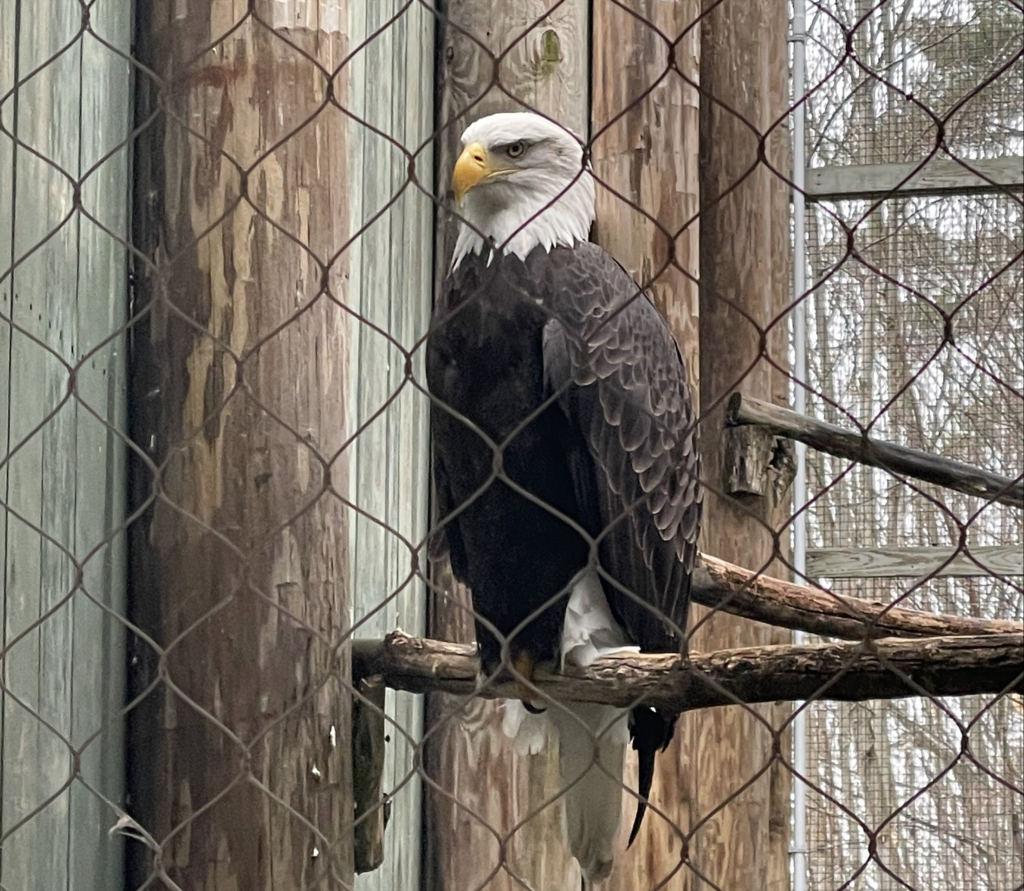
On Saturday, April 16, several Reviewers attended an “Owls Festival,” hosted by the Vermont Institute of Natural Science (VINS) at its Nature Center in Quechee. Upon our arrival, we immediately noted that it was not an especially auspicious day for a nature show chronicling creatures of flight. Indeed, rain and sometimes rather torrential downpours began to predominate from midday. We were personally unprepared for the rain, with not one of us having worn a raincoat or brought an umbrella. (Not that an umbrella would have helped us, anyway. But we’ll return to this later.) Ultimately, while it did soak our clothes, we were pleased that the rain had little impact on the Festival’s programming. Not one of the events which we had planned to attend was canceled, and only one had its venue changed (that is, moved out of the rain).
In the following, we have attempted to provide some measure of summary but more so a good deal of retrospection on the events which we attended, the sights which we observed, and our overall takeaways from visiting the VINS Nature Center for its “Owls Festival.”
The first event that we attended, entitled “Owl Quest,” was hosted in a covered pavilion that provided welcome shelter from the rain. Author and photographer Mark Wilson presented a slideshow on his pursuit to photograph all nineteen owl species native to North America. Mr. Wilson’s photographs were excellent, depicting a variety of exciting owls in their natural habitats. The owls stretched from the Northern Hawk Owl in the Canadian Tundra to the Spotted Owl “of the Mexican Variety” in the American Southwest. Mr. Wilson himself was humorous and entertaining, setting a nice upbeat start to VINS on the rather dreary day.
After “Owl Quest,” we ventured to a presentation on “Owl Rescue and Rehabilitation.” A VINS staffer outlined the Institute’s processes to help injured birds recover and, in the event their injuries prove permanently debilitating, to establish the Nature Center as their home. We found the presentation highly informative on the latest techniques of healthcare for our feathered friends as well as the valuable work which VINS does for them. One revelation to us was that owls do not have symmetrical ears; hence, they can hear from all directions. The most memorable moment from this rehabilitation presentation was a discussion of VINS’ efforts to return an injured Snowy Owl to flight readiness. This particular white predator had the unfortunate luck of landing in a pile of cow dung, which stole away both its elegant color and its ability to fly. The excrement had seeped into its feathers, rendering the λευκός bird too heavy for any aerial ascents!
We then spent some time traversing an exhibit area in which we saw numerous raptors (no, not the dromaeosaurid dinosaur; rather, “birds of prey”). Our favorites among these raptors were: a Great Horned Owl, the glowering “tiger of the sky”; two Snowy Owls, a male and female who seemed to be actively arguing; a long-tailed and pompously perched Cooper’s Hawk; and of course the incomparably magnificent Bald Eagle. It seemed to us that the Bald Eagle was aware of his popularity (there was a sizable audience gathered just beyond his enclosure) and was posing in rather magisterial fashion. We, of course, had no qualms with this and enjoyed snapping dozens of photos of him, exemplar that he was of the greatest raptor to ever rule the skies.
The final event that we attended was entitled “Raptors Up Close.” While originally slated to be held in the “Hawkfly,” an area positioned in the exact center of VINS, this event was moved to an area beneath an overhang so as to facilitate a dry event of a different sort than that which Dartmouth students strenuously avoid. We enjoyed observing the little fella brought out on a VINS staffer’s begloved hand wiggle about, flap his wings, and make loud screeches. His screeches became especially anxious and accentuated when a family of four began to walk through the rain towards our spot beneath the overhang. There was, we were told, a simple explanation: he gets nervous in the presence of umbrellas. We felt the word “nervous” was an understatement—this bird was terrified. When the family finally arrived at the event, the screeching was louder than ever, and they were asked to close their umbrellas. This, they did willingly, and our fine, feathered friend’s sounds soon slowed to a stop. The bird nevertheless continued to scowl at them and, given that the family was standing right behind us, appeared to be glaring right through us. A tad afraid that the bird would swoop at them, through us, we quickly scurried off to the side, thereby allowing him a clear path of attack.
Our trip to VINS for the “Owls Festival,” though somewhat wet, proved an agreeable Saturday excursion. We will doubtless return for future exhibits and festivals, and, even if it rains, we will be sure not to bring an umbrella.

Be the first to comment on "Review Reviews: VINS Owls Festival"